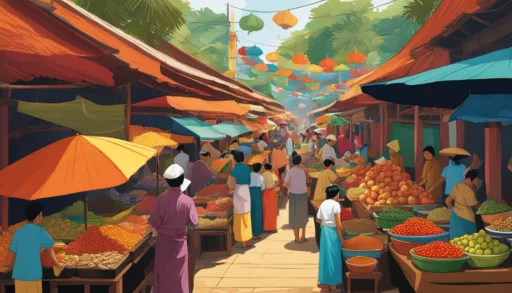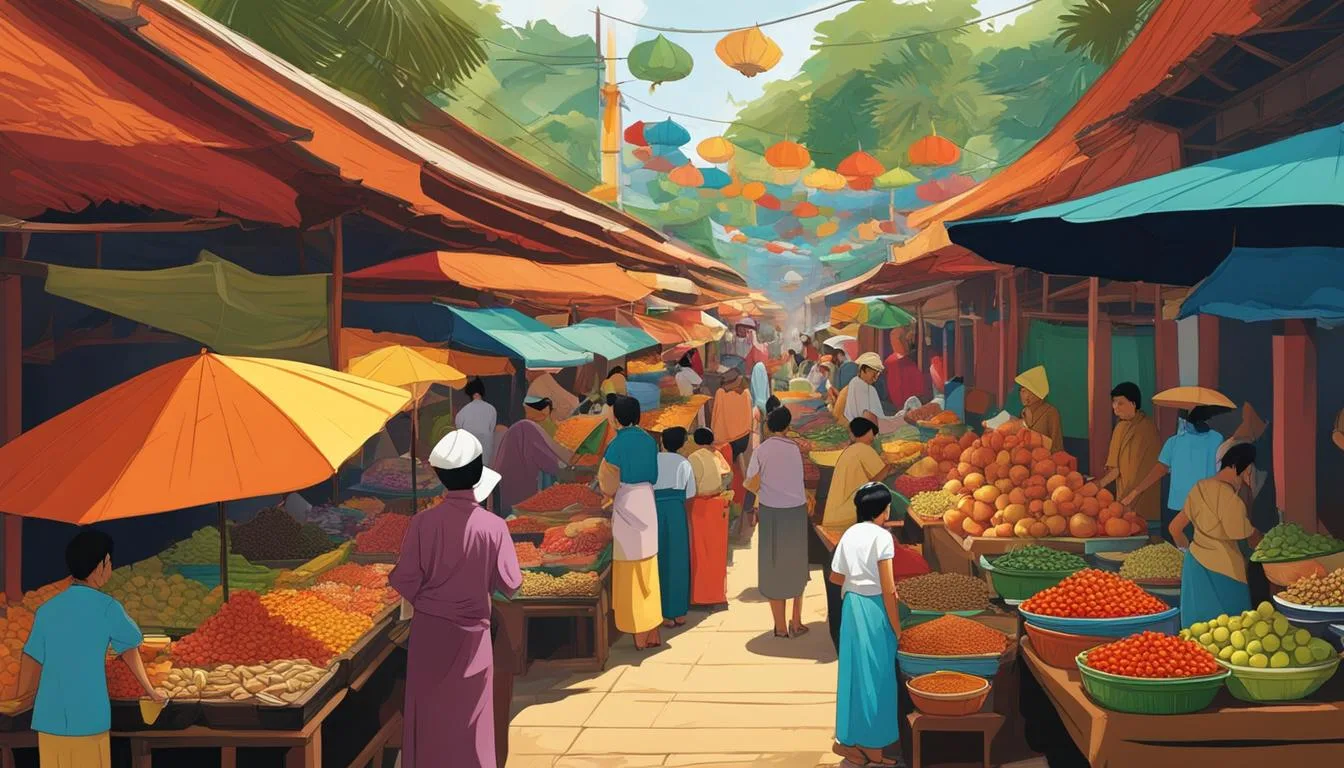In a nation where the lush rainforest meets the South China Sea, you’d expect an abundance of nature’s bounty, but what’s truly astonishing is that Brunei’s entire population could dine together in fewer than ten football fields. Despite its snug size, the Brunei food scene is extensive and diverse, offering an exploration into traditional Bruneian cuisine that is steeped in history and brimming with flavors. Adventurous foodies looking to delve into new culinary realms will find Brunei’s food exploration to be a unique and enlightening experience, from savoring the sticky complexity of Ambuyat to the aromatic spices perfuming bustling market stalls.
As you weave through the tantalizing labyrinth of exploring Brunei’s food scene, you’ll unearth dishes that tell the story of communal feasts, royal legacies, and cross-cultural trade routes, taste the essence of age-old tradition, and embrace the modern renditions elevating the nation’s legacy onto the global culinary map.
Key Takeaways
- Embark on a Brunei Food Exploration to discover a small nation with an impressively vast cuisine.
- Delight in traditional Bruneian cuisine, which includes the cultural and historical staple Ambuyat.
- Experience the communal spirit and authentic flavors while exploring Brunei’s food scene.
- Understand how Brunei marries its rich culinary heritage with innovative contemporary tastes.
- Witness how Brunei’s diverse dishes reflect its natural resources and commitment to hospitality.
- Appreciate the culinary evolution that honors Brunei’s past while exciting the modern palate.
The Unveiling of Brunei’s National Treasure: Ambuyat
At the heart of Brunei’s culinary landscape lies a dish not just beloved for its taste, but also cherished for its cultural significance. Ambuyat, a treasured embodiment of traditional Bruneian cuisine, offers a distinctive gastronomic experience that plunges its admirers into the core of Brunei’s rich food heritage.
Delving Into the Origins of Ambuyat
Derived from the interior of the sago palm, an evergreen that flourishes in Brunei’s lush ecosystem, Ambuyat holds its ground as one of the best Brunei dishes steeped in history. This gelatinous starch has been sustaining the people of Brunei for centuries, especially during times when other food sources were scarce.
Ambuyat in Contemporary Cuisine
Modern chefs in Brunei are now infusing Ambuyat with a touch of innovation, blending local Brunei flavors with contemporary elements. Despite the modern reinterpretation, the foundational method of enjoying Ambuyat remains unchanged, preserving the essence of its past.
The Communal Experience of Eating Ambuyat
There’s no solitary pleasure in enjoying Ambuyat; it is an experience meant to be shared. Encouraging a sense of togetherness, the communal nuances of its consumption are as important as the dish itself, fostering bonds over shared pots and intertwined ‘candas’.
A typical Ambuyat feast is not just about the food; it’s a display of kinship—a time to gather and indulge in a meal that truly captures the spirit of traditional Bruneian cuisine.
| Components of Ambuyat | Role in the Dish |
|---|---|
| The Starch (Ambuyat) | The base of the dish, providing sustenance and versatility |
| The ‘Candas’ | Bamboo sticks used to twirl and consume the Ambuyat |
| The ‘Cacah’ (Dip) | Typically a tangy sauce that complements the subtle taste of Ambuyat |
| Accompaniments | Vegetables, meats, and other local side dishes that enrich the meal |
Through the sago-infused delicacy of Ambuyat, one can journey through the tapestry of Brunei’s heritage, unraveling flavors that resonate with tales of survival, unity, and the preservation of traditional Bruneian cuisine.
Brunei’s Spice Route and Cultural Melting Pot
Embarking on a Brunei Food Exploration unveils the vibrant tapestry of culinary delights in Brunei, a saga of flavors and traditions that transcends time. Influences from the ancient spice route have left an indelible mark on traditional Bruneian cuisine, turning the country into a crossroad of diverse culinary currents that coalesce into a rich cultural melting pot.
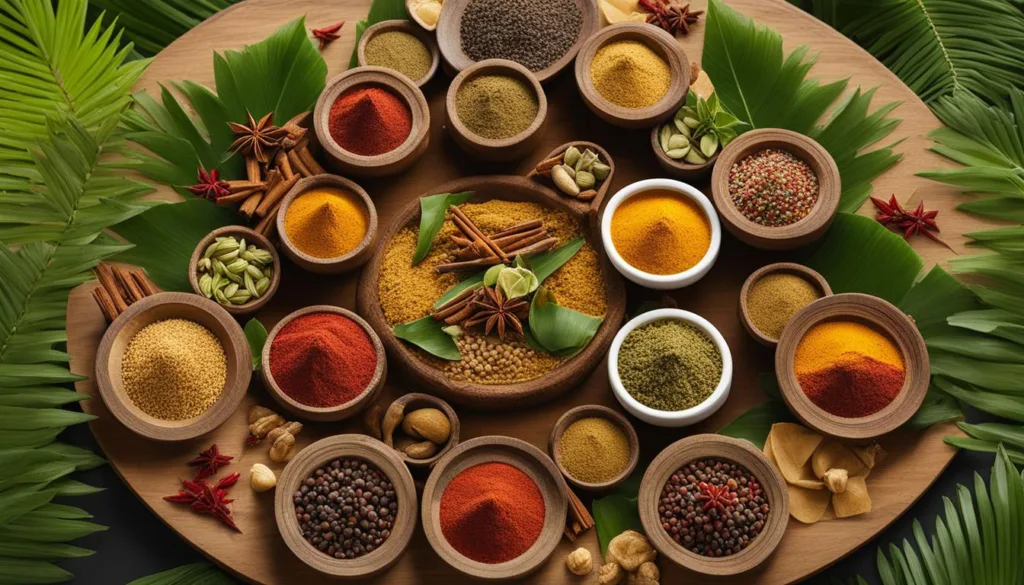
The heart of Bruneian cooking is livened by an array of spices, with coriander, turmeric, and cumin enhancing every facet of the nation’s gastronomy. These spices were carried along trade winds and seas, linking Brunei’s fare to a broader panorama of Asian cultures and flavors. Within this interconnected culinary map, each spice tells its shared history while adhering to Brunei’s unique culinary identity.
In its vibrant markets and street food stalls, the Chinese influence resonates through the art of noodle making while the essence of Malay culinary customs pulsates in the rhythm of local kitchens. The intersection of these cultural elements fashions a mosaic of dishes that are distinctively Bruneian—united in flavor but diverse in origin. As such, to explore Bruneian cuisine is to traverse a route peppered with historical ties, fragrant with enigmatic spices, and warm with the culinary embrace of a nation’s hospitable soul.
- The use of coriander in Bruneian marinades and curries
- Malay traditions in sambal concoctions and rice dishes
- Chinese-style noodle soups and stir-fries, steeped in regional authenticity
Whether it’s the allure of rustic cooking or the tailored tastes of modern fusion, Brunei’s culinary delights reflect an environment that celebrates its history rich in diverse immigration, abundant natural resources, and the open-armed welcome that is inherently Bruneian.
Indigenous Flavors: Brunei’s Tribal Culinary Heritage
Dive into the heart of authentic Brunei food, where each tribe contributes to a rich tapestry of local Brunei flavors. Brunei Food Exploration isn’t complete without tasting the tribal cuisine, a true manifestation of authentic Brunei food practices steeped in centuries-old traditions.
Iban tribe’s culinary offerings, distinctive ingredients processed in a fusion of forest-found bounty, grace the table with Pansuh, a dish where meat is cooked in bamboo segments with an array of aromatic herbs. Similarly, the Murut people celebrate with Tinonggilan and the smoky Sinalau Bakas, a testament to their rich cultural lifestyle. Meanwhile, the Dusun ethnic group makes use of river and jungle yields, delivering an earthy and robust flavor profile.
Iban Cuisine: From the Forest to the Feast
The Iban people, originally headhunters of the lush Bornean forests, uphold a culinary heritage that’s intrinsically connected with nature. Their cuisine, not merely food but a celebratory artifact, shares stories of tradition and foraged splendor.
Murut Culinary Customs and Celebrations
As one ventures deeper into the culinary heartland of Brunei, the Murut culinary customs emerge with rich festivities. Here, food acts as a chronicle of the tribe’s history and their intimate celebrations.
Dusun Delicacies: A Taste of the Jungle
The Dusun people add yet another layer to the local Brunei flavors. Their dishes, featuring ingredients such as bamboo shoots and wild ferns, transport one’s senses directly to the soul of Brunei’s rainforests.
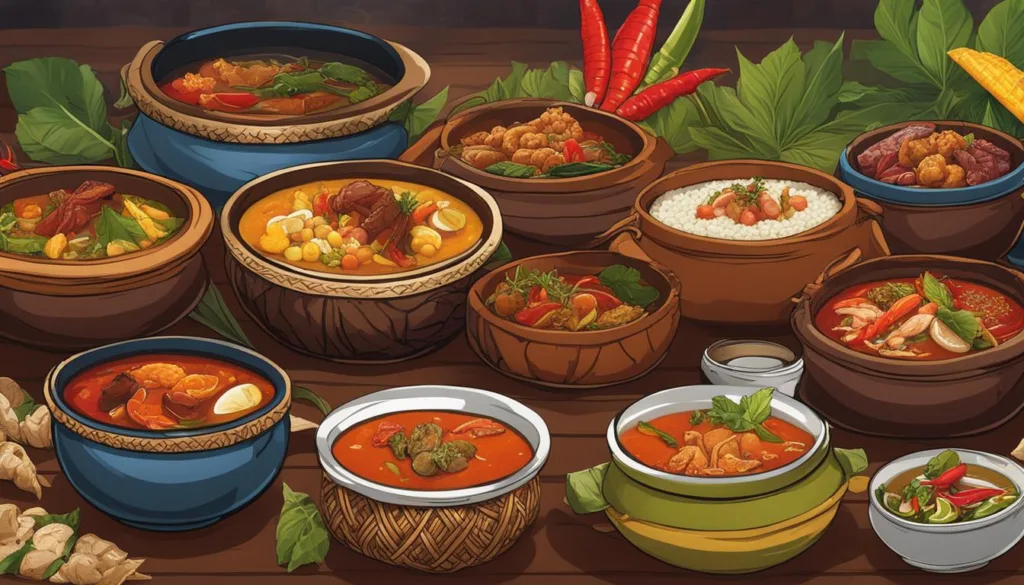
Engaging with these diverse tribes through their food paves the way for an immersive Brunei Food Exploration. One can truly appreciate the authenticity of each dish that reflects the tribes’ affinities with their surroundings and underscores their environmental wisdom.
- Pansuh Manok: Chicken cooked in bamboo with lemongrass and ginger.
- Layak: A cassava-leaf based dish, pungent and spicy, enjoyed among the Iban.
- Tinonggilan: Murut ceremonial wine, symbolizing unity.
- Sinalau Bakas: Wild boar smoked over an open fire, capturing the essence of Murut festivities.
- Ambuyat: A Dusun delicacy, turning sago into a shared culinary experience.
- Hinava: Tangy and refreshing, fish marinated in lime juice and spices.
Discovering the indigenous cuisines is like stepping into a world where every meal tells the story of survival, coexistence, and celebration of life. Brunei’s tribal communities offer up their heritage on a plate, making any Brunei Food Exploration an unmissable journey for the gastronomically adventurous.
The Essence of Bruneian Breakfast: From Classic Staples to Modern Eats
Brunei Food Exploration takes a flavorful turn during the early hours as locals indulge in a traditional Bruneian breakfast. These morning meals resonate with local Brunei flavors, providing a warm welcome to the beginning of the day and endorsing a practice steeped in tradition and communal dining.
Nasi Lemak: A Beloved Morning Tradition
Nasi Lemak is arguably the star of the breakfast scene in Brunei. This beloved dish is an enticing blend of creamy, coconut milk-infused rice served with a variety of savory accompaniments such as sambal, crispy anchovies, roasted peanuts, and fresh cucumber slices. A quintessential comfort food reflecting the region’s propensity for rich, aromatic flavors – Nasi Lemak embodies the heart of traditional Bruneian breakfast cuisine.
Roti Canai: The Influence of Indian Cuisine in Brunei
The culinary echoes of Indian influence surface with the widespread popularity of Roti Canai. This flaky, buttery flatbread is a staple in Brunei and acts as a vessel for the myriad of curries and dhal. It speaks of Brunei’s historic ties with India and showcases how these relationships have been savored and folded into the folds of the local culture and cuisine.
The Rise of Western Brunch Culture in Brunei
In recent times, the rising sun in Brunei also signals a burgeoning trend for Western brunch options. Tastebuds here now flirt with global flavors as cafés and eateries introduce fare such as avocado toast, eggs benedict, and artisanal coffees to their menus. This Western twist to the morning meals complements, yet distinctly contrasts, the traditional culinary ethos of Brunei.
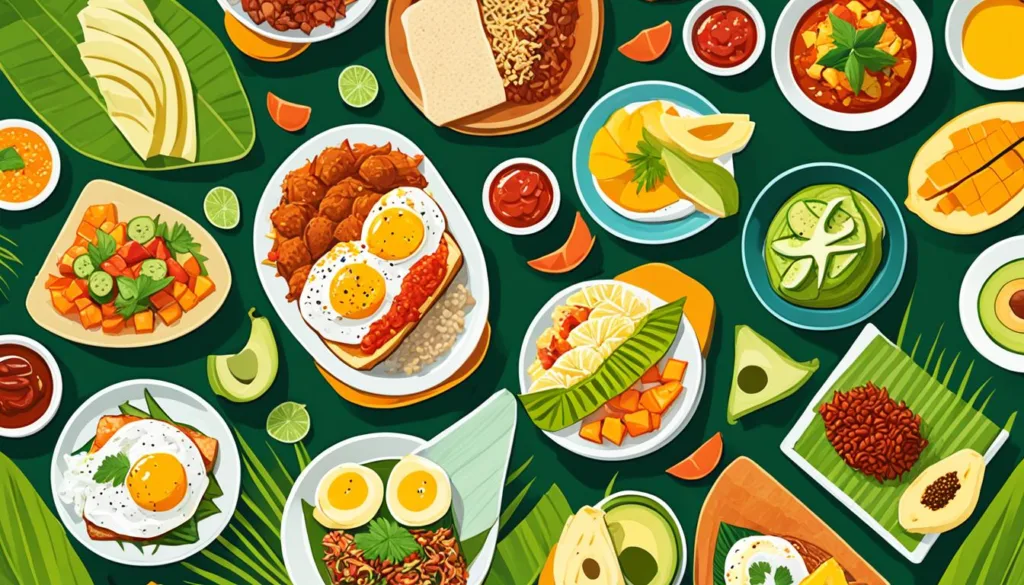
Let us further explore the textural and taste contrasts of Bruneian breakfast offerings:
| Dish | Main Ingredients | Taste Profile | Origin Influence |
|---|---|---|---|
| Nasi Lemak | Rice, Coconut Milk, Sambal, Anchovies, Peanuts, Cucumber | Rich, Spicy, Creamy | Malay |
| Roti Canai | Wheat Flour, Ghee, Curry or Dhal | Savory, Flaky, Buttery | Indian |
| Western Brunch Options | Various: Avocado, Eggs, Bread, Coffee | Varied, from Savory to Sweet | Western |
This exploration into the breakfast culture of Brunei underscores how the past is preserved and celebrated through age-old recipes and practices, even as new culinary influences find room on the breakfast plates, offering an evolving yet eternally authentic Bruneian gastronomical experience.
Brunei Food Exploration: A Tapestry of Tastes
Embarking on a Brunei Food Exploration is akin to venturing through a vibrant tapestry, woven with diverse threads of flavor and tradition. Each dish is a thread, contributing to the greater mosaic of traditional Bruneian cuisine. For travelers seeking the top Brunei food experiences, indulge in an array of dishes that are as eclectic as they are flavorful.
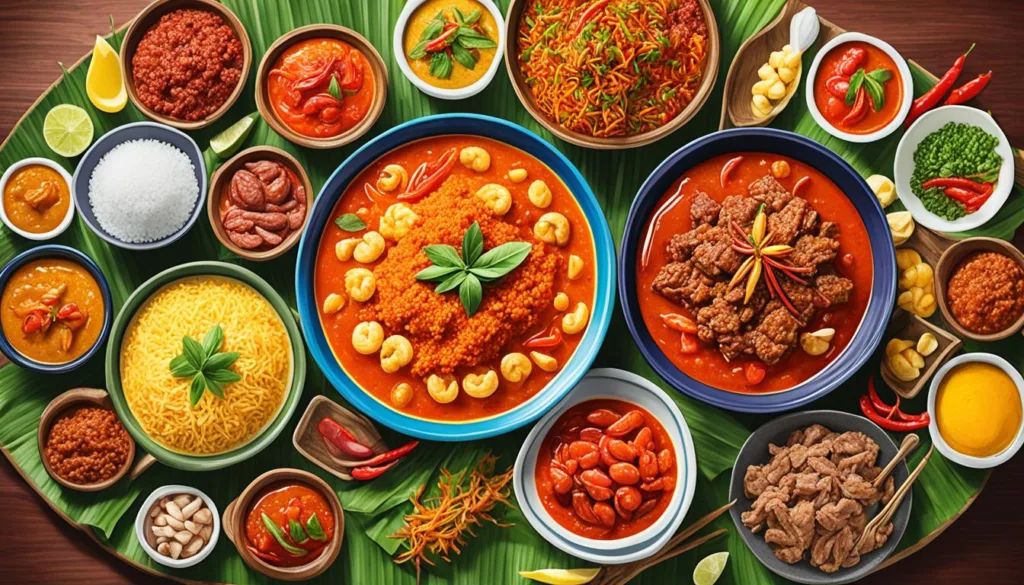
With its rich biodiversity, Brunei’s culinary landscape offers a bountiful selection of fresh produce that enhances the flavors of its cuisine. Local markets brim with colorful fruits, vegetables, and spices that are intricately laced within the recipes handed down through generations. This cornucopia of ingredients is a testament to Brunei’s natural abundance, creating a culinary identity that delights both the palate and the soul.
Discovering Brunei’s cuisine is an odyssey that taps into the nation’s very essence, a feast for the senses that narrates a story of heritage, unity, and innovation.
From the streets to the royal banquet halls, a collective of cultural influences from Malay, Chinese, to Indian has shaped the palate of this sequestered gem in Southeast Asia. Whether it is a simple bowl of richly spiced broth or a platter of succulent meats, each meal is a celebration of Brunei’s historical melting pot and its ongoing cultural evolution.
- Ambuyat, the quintessential Bruneian delicacy, offers a spicy tang that captures the heart of Bruneian communal dining.
- The sweet and savory notes of local street food embody the day-to-day indulgences of Brunei’s residents.
- An intricate blend of spices, each with its own story, seasons the traditional fare—infusing each dish with a burst of flavor that is distinctly Bruneian.
Therefore, whether one is a gastronome or a curious traveler, the culinary voyage within the heart of Brunei is not merely about savoring dishes. Rather, it is an intimate experience into the soul of a country—its people, its traditions, and the enduring legacy that is as sumptuous as it is profound.
Intertwined Tastes: The Integration of Seafood in Bruneian Cuisine
Brunei’s affinity with the sea is not only geographical but also gastronomical. The presence of the South China Sea and an extensive network of rivers has influenced local Brunei flavors, making seafood an integral component of Bruneian cuisine. This has led to a sustained fishing tradition and a trove of seafood culinary delights in Brunei, that both locals and visitors crave.
The Fishing Traditions of Brunei
In Brunei, the act of fishing is as much about preserving cultural heritage as it is about sustenance. Generations of Bruneians have cast nets into the azure waters, continuing a practice that stands as one of the nation’s pillars. Along the coastline and on the riverbanks, fishermen respect and honor the ecosystem that provides such rich bounty, aligning with Brunei’s overarching philosophy of environmental stewardship.
Signature Seafood Dishes to Savor
To truly participate in Brunei food exploration is to immerse oneself in the delectable seafood dishes that narrate the country’s oceanic narrative. The selection below represents the diversity and the piquant essence of Brunei’s seafood offerings:
| Dish | Description | Origin |
|---|---|---|
| Umai | A zesty raw fish salad, often likened to ceviche, seasoned with chilies, onions, and herbs. | Indigenous preparation with modern iterations. |
| Lintau | Fried or grilled fish wrapped in banana leaves delivering a smoky, aromatic flavor. | Traditionally enjoyed by Bruneian fishermen. |
| Ambuyat Cacah Binjai | A tangy and spicy dip made with Binjai fruit, perfect for complementing the bland Ambuyat. | A fusion of traditional ingredients with Ambuyat. |
| Buttered Prawns | Prawns enrobed in a rich, buttery sauce with a hint of spice and curry leaves. | A harmonious blend of local produce with international influences. |
From the time-honored techniques of preparing traditional lintau to the artistry involved in modern seafood presentations, the coastal kitchens of Brunei are an epicurean’s haven. Endeavoring a Brunei food exploration is to embark on a sumptuous journey savoring local Brunei flavors, particularly the seafood culinary delights in Brunei that celebrate the nation’s bond with the sea.
Spices and Seasonings: The Piquant Side of Brunei’s Culinary Scene
The marketplaces of Brunei bustle with the vibrant stories of spices that have sailed across the seas to land upon its shores, each granule and leaf contributing to the rich tapestry that is traditional Bruneian cuisine. With a heritage steeped in the trade of aromatic spices, Brunei has curated a pantry that can transform the simplest ingredients into dishes resplendent with flavor, evoking a centuries-old tradition of culinary excellence. For the passionate food enthusiast, Brunei Food Exploration is incomplete without delving into the variety of spices that are the keystones of Bruneian gastronomy.
Within the bustling stalls of Bandar Seri Begawan’s markets, one might discover the role of the following spices that define culinary delights in Brunei:
- Cardamom: Emitting a citrusy note, this pod is a hidden gem in sweet and savory dishes alike.
- Star Anise: Its licorice-like flavor adds depth to the dense broths of Brunei’s soups.
- Turmeric: This golden-hued spice lends its earthy warmth to many a Bruneian banquet staple.
The enchanting dance of these spices within Bruneian cuisine does more than just satiate hunger; it narrates a history of exchange, community, and innovation at the dinner table. To truly taste Brunei is to unravel the complex layers of seasonings that enliven each bite, a sensory tribute to the country’s natural bounty and its people’s culinary artistry.
Diversity at the Dining Table: Brunei’s Multiethnic Culinary Influence
The kingdom of Brunei isn’t just rich in natural resources, but also in its cultural tapestry, especially evident through its Brunei Food Exploration. Awaiting the gastronome is a world of culinary delights in Brunei, proudly influenced by the nation’s Chinese, Indian, and Malay populations. These communities don’t just coexist but intermingle, giving rise to a vibrant Brunei’s Spice Route of flavors and experiences. As the Brunei food scene continues to evolve, it becomes clear how each tradition plays a critical role in crafting the contemporary face of Bruneian cuisine.
Chinese Impact on Bruneian Cooking
One cannot explore Bruneian culinary delights without recognizing the substantial Chinese influence that pervades the nation’s kitchens. With every bite of the savory Mee Goreng, one tastes the traditional wok-fried noodles technique that Chinese culinary expertise has imparted. The use of soy sauce and fresh vegetables in quick, high-heat cooking, central to Chinese cuisine, can be found throughout Bruneian dishes, presenting a delectable unison of texture and taste.
Indian Flavors in Bruneian Dishes
The aromas of Indian cooking waft through Brunei’s morning breeze as fragrant spices blend in the air. One can’t help but savor the Roti Canai, a testament to India’s gastronomic contribution. The flaky, buttery bread served with dhal or curry is as much a staple in Brunei as it is in the Indian subcontinent. Indian spices like cumin, cardamom, and garam masala elevate Bruneian dishes to new heights, with flavors deeply ingrained in the nation’s food identity.
The Malay Contribution to Bruneian Cuisine
The effects of Malay heritage are ever-present in Bruneian fare. Skewered meats basted in peanut sauce, otherwise known as Satay, mirror the shared cultural and culinary history of the country. The Malay influence is synonymous with the essence of Brunei’s community-focused dining, where food is not merely sustenance but a means to bring people together. Rich coconut milk, aromatic lemongrass, and the fiery sambal paste are just a few of the ingredients Malays brought with them that are now mainstays in Bruneian cookery.
| Cuisine Influence | Iconic Dish | Key Ingredients | Core Cooking Technique |
|---|---|---|---|
| Chinese | Mee Goreng | Soy sauce, noodles, vegetables | Wok-frying |
| Indian | Roti Canai | Flour, ghee, spices (cumin, cardamom) | Pan-frying |
| Malay | Satay | Meats, peanut sauce, coconut milk | Grilling |
As Brunei continues to forge its path in the culinary world, its multiethnic influences shine through, offering a palate-pleasing journey through the crossroads of Asia. The mosaic of tastes found in Brunei are not just meals; they are stories of migration, trade, and the confluence of cultures that have crafted a unique dining saga waiting to be discovered.
A Journey Through Brunei’s Street Food and Local Markets
Embarking on a Brunei Food Exploration unveils a vibrant scene teeming with aromas, flavors, and the communal buzz of marketplaces. Experiencing the street food in Brunei is to partake in a ritual that goes beyond mere dining—it’s a cultural immersion where each bite tells a story of the nation’s rich and traditional Bruneian cuisine.
Nasi Katok: Brunei’s Go-To Comfort Food
The heart of Bruneian comfort food is encapsulated in the simple yet satisfying dish known as Nasi Katok. A staple that can be found at street corners and bustling food stalls, Nasi Katok serves up a culinary tale of Brunei’s heritage in each serving.
Savouring Snacks and Sweets at Brunei’s Open-Air Markets
The open-air markets of Brunei are kaleidoscopes of taste where locals and visitors alike can indulge in a cornucopia of snacks and sweets. These hubs of gastronomic delight showcase the diversity of Brunei’s palate, offering everything from savory delights to tantalizing treats.
| Market Delicacy | Description | Origin Influence |
|---|---|---|
| Nasi Katok | Rice served with spicy fried chicken and sambal | Bruneian |
| Kuih-Muih | Assorted traditional Malay cakes and pastries | Malay |
| Roti Kuning | Sweet yellow bread, often enjoyed with butter or coconut jam | Indian |
Sustainably Sourced: How Bruneian Cuisine Reflects Environmental Stewardship
As the world turns its focus on sustainable practices, Brunei Food Exploration provides a unique window into how traditional Bruneian cuisine harmonizes with environmental stewardship. The rich tapestry of authentic Brunei food experiences showcases a commitment to ecological mindfulness, where the culinary arts flow in rhythm with nature’s offerings.
Integral to this sustainable culinary journey is the use of ingredients sourced from Brunei’s lush forests, clean rivers, and abundant seas. These natural habitats, cared for by generations, continue to bless the tables of Bruneians with a bounty of fresh and nourishing produce. It’s within this context that traditional Bruneian cuisine gains its essence, a testament to a community that values the heritage of its land and the conservation of its resources.
From the careful selection of wild herbs to the responsible catch of the day, the core tenets of Brunei’s food landscape stem from a place of respect for the environment. This philosophy of balance and care weaves into every facet of the food preparation process, highlighting how authentic Brunei food experiences are not merely about taste, but also about maintaining a sustainable relationship with nature.
- Farm-to-table practices ensuring fresh, locally-sourced ingredients
- Preservation of age-old fishing techniques that avoid overfishing
- Culinary techniques that minimize waste and maximize flavor
- Strong community support for local produce markets
In an age where the world seeks to balance development with sustainability, Brunei stands as a glowing example, particularly within its culinary realm. By partaking in the Brunei Food Exploration, one doesn’t just enjoy the flavors of the nation, but also partakes in an ongoing legacy of environmental care and cultural pride.
Conclusion
As we journey through the vibrant alleyways and lush landscapes that shape Brunei’s food scene, we find that it is not just about savoring the best Brunei dishes but also about embracing a narrative woven from the tendrils of history, ecology, and kinship. The national staple Ambuyat emerges as a symbol of cultural continuity, asserting Brunei’s culinary identity and providing an anchor to the past while opening the palate to innovative interpretations. This viscous delicacy is just one example of how the resilient spirit of Brunei permeates every entree and appetizer in this gastronomic tableau.
Exploring Brunei’s food scene immerses one in a sensory mosaic, spotlighting the crucial role of its azure seas, aromatic spices, and diverse community. Insight is found in the sustainable approach of indigenous fare, the complexity of flavors born from the fusion of assorted cuisines, and the meticulous preservation of culinary methods that have traveled through time. For those invested in Brunei Food Exploration, the journey delivers an authentic interaction with a country that is as much a steward of its bountiful environment as a curator of an ever-evolving epicurean spectacle.
Indeed, unveiling the extensive and intricate layers of Bruneian cuisine reveals a distinctive blend of the archaic and the avant-garde, the local and the global. The result is a testimonial to Brunei’s rich gastronomic legacy—as enduring as it is dynamic—offering both an ode to tradition and a toast to future progressions. Thus, from the first taste of succulent seafood to the final bite of a spicy delicacy, the invitation stands: to delve deeply into the heart of Brunei where each dish is a story waiting to be told and a flavor waiting to be discovered.
FAQ
What is Brunei’s national dish and its significance?
Brunei’s national dish is Ambuyat, which is a starchy extract from the sago palm tree. This traditional dish signifies the nation’s history, culture, and a sense of community. It is particularly renowned for symbolizing resilience during food scarcities in times such as World War II.
Can I find modern interpretations of Ambuyat on my Brunei Food Exploration?
Yes, contemporary chefs in Brunei have incorporated modern twists into the preparation and presentation of Ambuyat, blending it with different flavors or serving it alongside contemporary dishes.
What distinguishes Bruneian cuisine from other Southeast Asian foods?
Bruneian cuisine is characterized by a rich fusion of various cultural influences, including Malay, Chinese, and Indian, along with a deep respect for the environment and its bounties. The culinary practices often showcase spices traded along the ancient spice route, enhancing the authenticity of its flavor profile.
What are some tribal dishes I should try while exploring Brunei’s food scene?
You should consider sampling dishes such as Iban’s Pansuh, Murut’s Tinonggilan, and Dusun’s Hinava to experience the tribal culinary heritage of Brunei, each offering a unique taste of the jungle.
What is a traditional Bruneian breakfast like?
A traditional Bruneian breakfast often includes Nasi Lemak, a dish infused with rich coconut flavors, and Roti Canai, which reflects the centuries-old Indian influences within Brunei’s culinary landscape.
Are there any seafood specialties in Brunei that I shouldn’t miss?
Brunei, with its rich fishing traditions, offers a variety of seafood delights. Be sure to try Lintau, a unique preparation of seafood, as well as other fresh, flavor-packed seafood dishes local to the region.
How does exploring Brunei’s street food offer a view into its culture?
Exploring Brunei’s street food provides an immersive experience into the country’s culinary tradition and cultural diversity. From Nasi Katok to an assortment of snacks in open-air markets, you can savor the authentic taste of Bruneian compassions and community life.
In what ways does Bruneian cuisine reflect the country’s commitment to environmental stewardship?
Bruneian cuisine often utilizes sustainably sourced ingredients from the country’s forests, rivers, and seas. Traditional cooking methods and dishes emphasize Brunei’s dedication to preserving natural resources and maintaining a balanced ecosystem.
Where can I experience the communal eating tradition of Ambuyat in Brunei?
Communal eating of Ambuyat is a widespread custom in Brunei, typically found in local restaurants and during special occasions. Look for eateries that offer traditional Bruneian cuisine to enjoy this unique dining experience surrounded by locals.
Are there any cross-cultural culinary experiences unique to Brunei?
Brunei’s food scene is a melting pot of various ethnic cuisines. You’ll find cross-cultural experiences in dishes such as Mee Goreng, which showcases Chinese techniques, and the inclusion of Indian spices in various local dishes, alongside classic Malay flavors.
